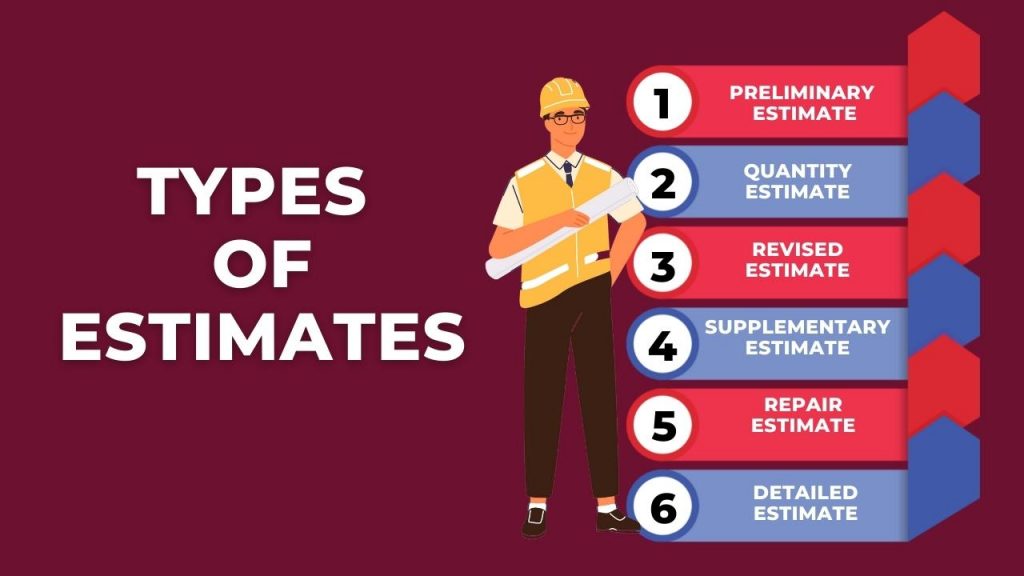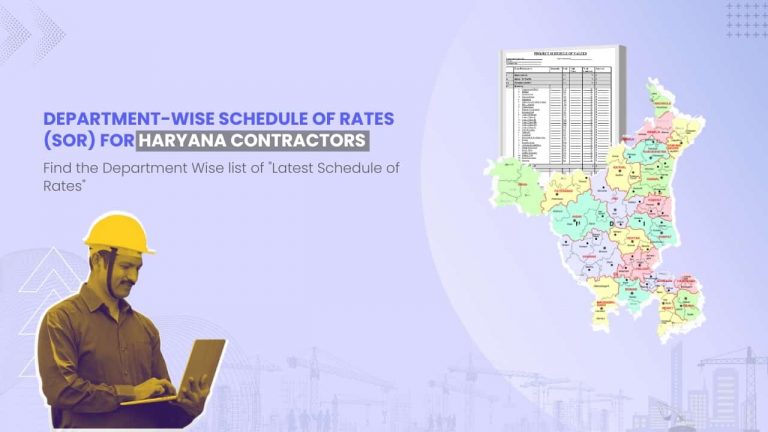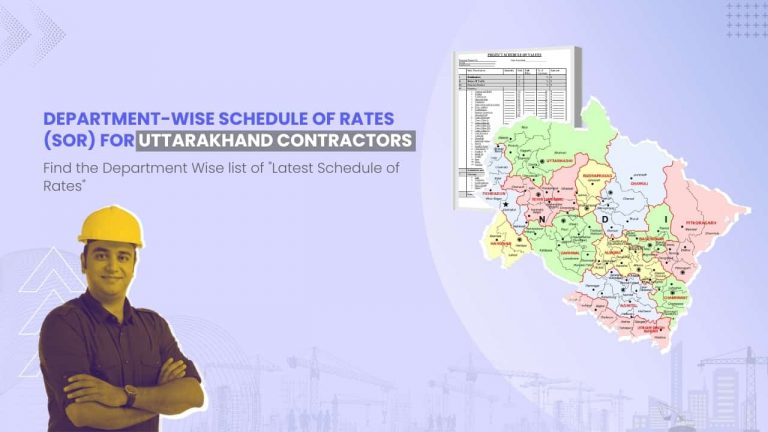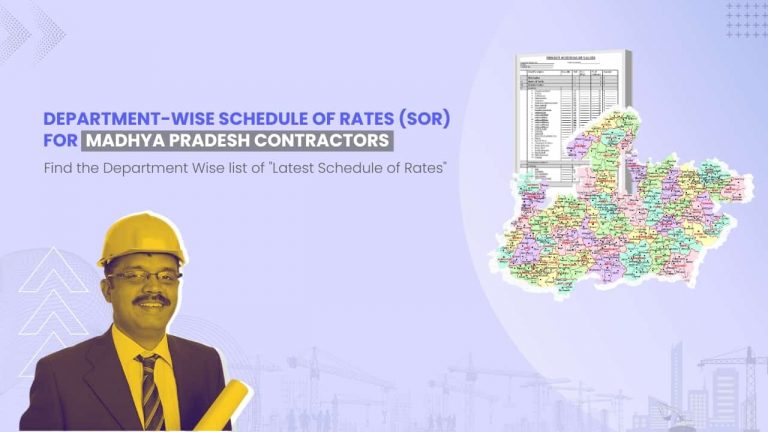
Before knowing the types of estimates, you must understand what a construction estimate is. Construction estimates are used for estimating the costs of a construction project so that contractors can execute the projects with intelligent planning of every activity. With the help of construction estimates, contractors can make a plan for every activity and predict the overall cost of the project by accurately preparing the cost estimates of everything involved.
One more thing which helps the contractors is that estimates help them predict their profit margins even before the start of the project so that they can decide whether or not they should opt for the project.
Types of Construction Estimates
Different construction estimates are prepared at different levels of the construction process. For example, suppose you have to work on a project, and there is not much information and specifications available for that project, then at this moment. In that case, a “preliminary estimate” is prepared at the beginning of the project.
However, the accuracy of these estimates is not that high as these are prepared with minimal information, whereas on the other hand, if you have a complete set of conditions and specifications of the project, then a “detailed estimate” is prepared, the accuracy of these types of estimates are very high as these contains all the necessary documents and conditions.
1- Preliminary or Rough Estimate
A preliminary estimate is the approximate cost of the project that is calculated at the conceptual stage of the project. It forecasts the total budgeted cost of the specific construction project. Apart from new construction, It can also be prepared for demolition or renovation works.
The preliminary cost estimate of buildings is based on areas and length measurements of various structural elements. Moreover, the total square footage of the plot is also considered to get the approximate cost of building the house, plaza, or multi-story building.
Most of the clients require a preliminary budget estimate from contractors, and It helps to get a rough idea about the total expenses for the completion of the project. Depending upon the type of infrastructure, the estimation technique and units may change.
2- Quantity Estimate
A quantity estimate includes a list of quantities for all materials needed to complete a project. Its purpose is to give the client a complete list of all the quantities required for the project and the cost for each quantity. It is a required estimating method in construction. This is a complete estimate or list of quantities for all work items required to complete the project. The quantity of each work item is worked out from the respective dimensions on the structure drawing.
Also Read: 6 Smart Methods to Prepare Accurate Estimate for Building
3- Revised Estimate
A revised estimate is a detailed estimate of the revised quantities and rates of items of work initially provided in the estimate. When the sanctioned amount exceeds more than 5%, either due to rates being found insufficient or due to some other reasons, a revised estimate is prepared.
A comparative statement is attached on the last page. It includes reasons for an increase in cost in the case of each item. Revised estimates should show the variation of each item of work, its quantity rate, and cost under original and revised.
4- Supplementary Estimate
While work is in progress, some additional work may become necessary for the project’s development, which was not included when the original estimate was prepared. For this reason, a freshly detailed estimate, in addition to the original sanctioned estimate, was prepared to describe the additional work, which we called the supplementary estimate.
During the progress of the work, some modifications or additions due to material deviation of a structural nature from the design initially approved may be necessary for the development of a project. A supplementary estimate includes all such works.
5- Annual Maintenance or Repair Estimate
Repairing is done for structures to keep them in perfect condition. After completing a work, it is necessary to keep the maintenance aspect in view for its proper functioning, for example, in the case of building whitewashing, oiling, painting, cement plaster repairs, and repairing floors, etc.
For these types of repairing, annual repair estimates are prepared for the items which require renewal, replacement, repairs, etc., for maintenance purposes. In no case, the annual repair amounts should be increased to greater than 45% of the capital cost of the building.
6- Detailed Estimate
These estimates are prepared when all the specifications and conditions of the projects are available. In the case of government tenders that the PWD releases, CPWD, Irrigation, or any other department, they release an NIT(Notice inviting tenders).
In these NITs, all the specifications of projects are mentioned, which can be used for preparing detailed estimates. The accuracy of detailed estimates is very high compared to the preliminary estimate because these are prepared with complete information about the projects.
Conclusion
Construction cost estimates are among the most critical components of your business’s profitability and winning new tenders. It’s essential to be as accurate as possible. This is why you must complete construction estimating to ensure you get everything. A contractor or any construction worker should always be very aware of the importance of construction estimates in the construction process to provide a successful bid.
Also Read: Smart Tips For Calculating Accurate Construction Costs In Construction Estimates
Popular FAQs on Estimates
Q1: What is a construction estimate, and why is it crucial for contractors?
Answer: A construction estimate is a vital tool in construction projects. It helps contractors predict costs, plan activities, and make informed decisions. Understanding construction estimates is essential for successful bidding and project execution.
Q2: What are the types of estimates used in construction?
Answer: There are various construction estimates, including Preliminary or Rough Estimate, Quantity Estimate, Revised Estimate, Supplementary Estimate, and Annual Maintenance or Repair Estimate. Each estimate serves a unique purpose in construction planning.
Q3: What is a Preliminary or Rough Estimate, and when is it used?
Answer: A Preliminary or Rough Estimate provides an approximate project cost at the project’s initial stage. It is crucial for clients to gain an early cost estimate and contractors to gauge project feasibility.
Q4: What does a Quantity Estimate involve, and why is it significant?
Answer: A Quantity Estimate lists all required materials and their costs. This estimate is critical for project planning and budgeting, ensuring that all materials are accounted for.
Q5: When is a Revised Estimate prepared, and what does it include?
Answer: A Revised Estimate is created when the sanctioned budget exceeds 5% due to rate discrepancies or other factors. It includes detailed revisions to quantities and rates from the initial estimate.
Q6: What is a Supplementary Estimate, and why is it needed?
Answer: A Supplementary Estimate covers additional work required during a project, not originally included in the initial estimate. It accommodates modifications and additions, ensuring project completion.
Q7: How are Annual Maintenance or Repair Estimates used, and why are they essential? Answer: Annual Maintenance or Repair Estimates are employed for post-project upkeep. These estimates cover maintenance activities like painting, repairs, and replacements, ensuring structures remain in good condition.
Q8: What distinguishes Preliminary from Detailed Estimates, and when are they used? Answer: Preliminary Estimates provide rough costs with limited information, while Detailed Estimates offer high accuracy with complete project details. Detailed Estimates are used when comprehensive project information is available.
Q9: Why is construction estimating significant for contractors’ success?
Answer: Construction estimating is vital for contractors as it ensures accurate cost prediction, profitable bidding, and successful project execution, enhancing business success.
Q10: What should contractors understand about construction estimates to improve their competitiveness?
Answer: Contractors must grasp the importance of construction estimates in bidding, project planning, and profitability. This knowledge enhances competitiveness and secures project opportunities.

People also search for: construction estimate, building estimate, estimate building costs, estimate of building, building estimates, how to make an estimate for construction, house construction estimate, how to estimate construction, how to estimate a building, how to estimate building cost, building work estimates, house building estimates, estimation of a house, how to do an estimate for construction, builders estimate, builders estimates, how to do estimates for construction







